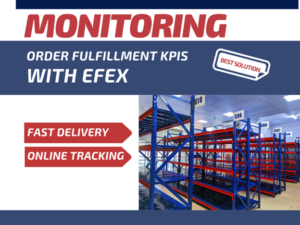10 Key Fulfillment KPIs: Measure Supply Chain Success

In the competitive world of logistics and supply chain management, tracking key performance indicators (KPIs) is essential for maintaining efficiency, reducing costs, and ensuring customer satisfaction. Fulfillment KPIs provide valuable insights into the performance of your fulfillment operations, highlighting areas for improvement and helping you make data-driven decisions. This blog will explore ten critical fulfillment KPIs that you should measure to gauge the success of your supply chain.
The logistics and supply chain industry is complex, involving multiple processes that must work seamlessly together to ensure timely and accurate delivery of products. From warehousing to transportation, each step has its unique challenges and performance metrics. Businesses can streamline their operations, reduce errors, and enhance overall efficiency with only focusing on the right KPIs. In the following sections, we will delve into the essential KPIs for different aspects of the fulfillment process, including customer metrics, warehouse metrics, operational metrics, and financial metrics.
10 Fulfillment KPIs You Cannot Ignore
Measuring the right KPIs is crucial for assessing the performance of your fulfillment center and overall supply chain operations. Here are ten essential KPIs you need to track:
Customer Metrics
On-Time Shipping
Definition: On-time shipping measures the percentage of orders shipped on or before the promised delivery date.
Formula:
Importance: High on-time shipping rates enhance customer satisfaction and loyalty, ensuring that customers receive their orders when expected.
On-time shipping is critical because it directly affects customer satisfaction. In today’s fast-paced world, customers expect their orders to arrive promptly. Delays can lead to dissatisfaction, negative reviews, and ultimately, loss of business. This KPI can help businesses identify bottlenecks in their shipping process and take corrective actions to ensure timely deliveries.
Order Cycle Time
Definition: Order cycle time is the total time taken from when an order is placed until it is delivered to the customer.
Formula:
Importance: Reducing order cycle time improves customer satisfaction and can lead to higher repeat business.
Order cycle time is a crucial metric as it encompasses the entire fulfillment process, from order placement to delivery. A shorter cycle time indicates a more efficient fulfillment process, which can lead to increased customer satisfaction and repeat business.
Order Picking Accuracy
Definition: Order picking accuracy measures the percentage of orders picked and packed correctly without errors.
Formula:
Importance: High picking accuracy reduces returns and increases customer satisfaction by ensuring that customers receive exactly what they ordered.
Order picking accuracy is vital for maintaining customer satisfaction and minimizing returns. Incorrect orders can lead to customer dissatisfaction, increased return costs, and a negative impact on the brand’s reputation. Based on this KPI, businesses can identify issues in their picking process and implement measures to improve accuracy, such as better training for pickers or investing in technology like barcode scanners.
Warehouse or Inbound Metrics
Average Warehouse Capacity Used
Definition: This KPI measures the average percentage of warehouse space utilized over a specific period.
Formula:
Importance: Optimizing warehouse space usage can lead to cost savings and more efficient inventory management.
Effective utilization of warehouse space is crucial for cost management and operational efficiency. Underutilized space represents wasted resources, while overutilized space can lead to inefficiencies and safety issues. When businesses monitor this KPI, they can make the most of their available space, potentially reducing the need for additional storage facilities and lowering costs.
Inventory Accuracy Rate
Definition: Inventory accuracy rate measures the accuracy of inventory records compared to physical inventory.
Formula:
Importance: Accurate inventory records are crucial for meeting customer demand and avoiding stock outs or overstock situations.
Inventory accuracy is essential for effective inventory management. Discrepancies between recorded and actual inventory levels can lead to stockouts, overstocking, and increased holding costs. This KPI supports businesses to identify inaccuracies in their inventory records and take corrective actions, such as conducting regular physical inventory counts and implementing better inventory management systems.
Peak Warehouse Capacity Used
Definition: This KPI measures the highest percentage of warehouse space utilized during peak times.
Formula:
Importance: Understanding peak capacity usage helps in planning for peak seasons and avoiding space constraints.
Monitoring peak warehouse capacity usage is crucial for planning and managing seasonal fluctuations in demand. During peak times, such as holidays or promotional periods, warehouse space can become a constraint, leading to operational inefficiencies and delays.
Operations or Outbound Metrics
Order Fill Rate
Definition: Order fill rate measures the percentage of customer orders that are fulfilled completely on the first shipment.
Formula:
Importance: High order fill rates ensure that customers receive their complete orders, enhancing satisfaction and reducing the need for follow-up shipments.
Order fill rate is a key indicator of a fulfillment center’s efficiency in meeting customer demand. A high fill rate means that customers receive their entire order in a single shipment, reducing the need for backorders and partial shipments. This not only improves customer satisfaction but also reduces shipping costs and administrative burdens associated with multiple shipments.
Orders Picked per Hour
Definition: This KPI measures the average number of orders picked per hour by warehouse staff.
Formula:
Importance: Tracking this KPI helps in assessing workforce efficiency and productivity, allowing for better labor management.
Orders picked per hour is a productivity metric that helps businesses evaluate the efficiency of their warehouse staff. Higher productivity levels can lead to faster order processing times and reduced labor costs.
Financial Metrics
Distribution Costs (Per Unit Shipped)
Definition: Distribution costs per unit shipped measure the cost associated with shipping a single unit of product.
Formula:
Importance: Lowering distribution costs per unit shipped can significantly improve profitability and competitiveness.
Distribution costs per unit shipped is a critical financial metric that impacts the overall profitability of a business. Lower distribution costs can lead to increased margins and a more competitive pricing strategy.
Inventory Days of Supply (IDS)
Definition: IDS measures the number of days the current inventory will last based on the average daily sales rate.
Formula:
Importance: Maintaining optimal inventory levels helps in avoiding stockouts and reducing holding costs.
Inventory days of supply is a crucial metric for managing inventory levels and ensuring that businesses can meet customer demand without overstocking. Businesses can maintain optimal inventory levels, reducing the risk of stockouts and minimizing holding costs.
Monitoring Order Fulfillment KPIs With EFEX

Tracking and analyzing these KPIs can be a daunting task, especially without the right tools. EFEX, a comprehensive Warehouse Fulfillment Service in Vietnam, offers robust solutions to monitor and improve your fulfillment performance. With EFEX, you can easily track fulfillment center KPIs, gain valuable insights, and make informed decisions to enhance your supply chain operations. Whether it’s optimizing your warehouse space, improving order accuracy, or reducing distribution costs, EFEX provides the tools and support you need to succeed.
EFEX’s advanced analytics platform allows businesses to monitor their fulfillment KPIs in real-time, providing actionable insights to improve operational efficiency and customer satisfaction. EFEX’s technology helps businesses automate data collection, streamline reporting, and gain a comprehensive view of their fulfillment performance. This enables proactive decision-making and continuous improvement in the supply chain.
In conclusion, measuring and analyzing these ten key fulfillment KPIs will help you improve your supply chain efficiency, enhance customers. With EFEX Asia‘s all-in-one e-commerce order fulfillment solution, businesses can confidently expand their global reach and provide exceptional service to customers worldwide. Embrace the power of international fulfillment and unlock new opportunities for growth in the global e-commerce market.




